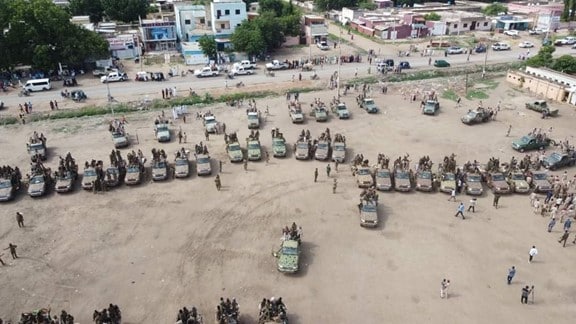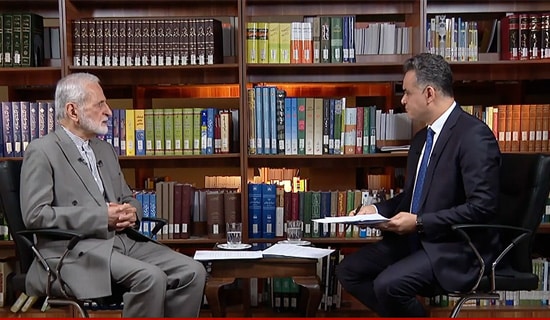The carnage is horrifying. Initial reports on July 18 talked about 60 to 70 dead but later information puts it at up to 200 hundred civilians killed and 14,000 people displaced in tribal fighting in Sudan's Blue Nile State. Health authorities asked for additional help in treating the many wounded, beyond the capacity of an underfunded local medical system to care for the injured.

Joint Forces (RSF, SAF, Police) arriving in Al-Damazin, Blue Nile State to restore order.
In the regional media some of the discourse was predictable. A piece on a pan-Arab television network interviewed local men on the ground in Blue Nile State. All of them deplored the violence and noted the tolerance and pluralism that has characterized the state, with many different tribes and ethnic groups. One noted that "we have never seen anything like this" and called for peaceful coexistence.[1]
The reality of what happened on the ground is rather more complicated than man-on-the-street interviews would lead one to believe. Blue Nile is a heavily militarized zone, it became one of the battlefield states, along with neighboring South Kordofan, in the decades-long struggle between the Sudan People's Liberation Movement/Army (SPLM/A) and the government in Khartoum, usually represented on the ground by the Sudanese Armed Forces (SAF). The state is both rich in natural resources and filled with the poor, like most of Sudan. The tribal factor, and struggles over land and resources, were and remain key elements of conflict in the state.
In the war between Khartoum and rebels that raged for years, the tribal dimension was often of great importance. Rebel groups often drew from certain ethnic groups more than others and Khartoum would – in true imperial fashion – arm and unleash the traditional rivals of their enemies.
The SPLM in Blue Nile state during the years of the Sudanese Civil War (1983-2005 and, after the independence of South Sudan, 2011-2020) drew heavily from the Ingessana and Uduk peoples (SPLM leader and former Blue Nile Governor Malik Agar is Ingessana). Khartoum recruited paramilitary proxies among rival groups, such as the Felata and Hausa, tribal groupings originally from West Africa and 20th-century newcomers to the region. But tribal and factional loyalty were sometimes not so clear cut. The Kobaji militia created by Khartoum to fight the Malik Agar-led SPLA included fighters from the Al-Hamaj tribe who switched sides from the SPLA in 2015 to the SAF militia. The reason for the defection was friction with Agar but also the need to acquire better weapons to defend against other groups – like the Felata and Hausa – who coveted Al-Hamaj land.[2]
Not so coincidentally, the recent fighting and massacres were between the Hausa and Al-Hamaj, an ancient Blue Nile tribe with antecedents going back to the medieval Funj Sultanate of Sennar, against a "new" 20th-century arrival in the Hausa. The details are, as often happens in these situations, murky, but it includes "hate speech" and incitement, land issues, and fears by the Al-Hamaj that the Hausa are being favored by their old patrons in the Sudanese military and demanding rights they do not deserve.[3] The current tensions go back months.[4] Other reports describe the clashes as being between the Hausa and the Ingessana[5] or the Hausa and the Berta (Berta, Al-Hamaj and Funj are essentially the same). Most of the victims seemed to have been Hausa.
The state's current governor, veteran former SPLM/A rebel Ahmed Al-Umda (himself an Ingessana and deputy to Malik Agar during the war) described Blue Nile as a miniature version of Sudan and vowed to take a hard line against ethnic incitement and uphold the rule of law.[6] Critics of military rule note that Agar and other Juba Peace Agreement signatories have shown themselves to be allies of the military. The SPLM in Sudan is today split along ethnic lines, even in Blue Nile State.
The Sudanese military (SAF plus their rivals/partners in the Rapid Support Forces or RSF) overthrew the country's interim civilian government on October 25, 2021 and has attempted to maintain power ever since then, despite a popular pro-democracy movement and the cut-off of aid by Western countries. One way the military regime has tried to push back against the pro-democracy movement in the streets is by using tribal elements, including traditional tribal leaders, both before and after the October 25th coup. A blockade by Beja tribal leaders in East Sudan and the acquiescence of former rebel leaders from Darfur and Blue Nile were key elements in the military coup. Former Sovereignty Council member Mohammed Al-Faki Suleiman blamed the military (which imprisoned him in October 2021 and only released him in April 2022) for being behind the increase in tribal violence, not just in Blue Nile but throughout the country, since the coup. This was "carefully planned, and not spontaneous," he noted on his Facebook page.[7] Hausa leaders at a July 20 press conference agreed, to a point, that it was planned and organized, but blamed the local government, controlled by the SPLM/A rather than Khartoum. Ethnic Hausa in other Sudanese cities rioted in solidarity with their brethren in Blue Nile.
SUPPORT OUR WORK

Certainly, the centrifugal forces potentially leading to greater violence and chaos are picking up steam in Sudan. There has been recent unrest in the east and north of the country, more massacres in Darfur, and worsening economic conditions.
The military is eager to retain real power (security, foreign affairs, banking) while handing over the messy parts of governing to a civilian government that can deflect the blame for the coming disasters away from the armed forces. That is assuming the civilians and politicians can agree to a government where they would be at the mercy of the soldiers at any moment.[8] According to the UN, there has been a dramatic increase in hunger with over 30 percent of Sudan's population facing "acute food insecurity."[9] Meanwhile, as hunger looms, Sudan's wheat rots in store houses because the government cannot afford to buy it.[10] If we are seeing this violence now, how will it be in six months when prices are even higher and food stocks lower?
The military itself though, pulling strings and manipulating internal events and foreign diplomats, is also divided although it strives manfully to present a united front. The military regime's two leaders, interim head of state SAF General Abdel Fatah al-Burhan and his deputy RSF General Muhammad "Hemeti" Dagalo are partners but also rivals. If Al-Burhan aspires to be Egypt's President Al-Sisi, Hemeti looks to emulate Chad's Idris Deby. Both have important foreign ties. Al-Burhan, despite SAF's continuing ties with Sudan's former ruling Islamists, is very close to Al-Sisi's Egypt. Hemeti cultivates closer ties with the UAE, with Russia, and even with Israel. Both Al-Burhan and Hemeti seek allies among former rebel groups in order to bolster their ranks. Hemeti's troops were among the first on the ground to help restore order in Blue Nile.[11]
Into such a bubbling cauldron comes the first U.S. ambassador accredited to Sudan in 25 years. Career diplomat John Godfrey was confirmed by the Senate on July 14. He will be presenting his credentials to General Al-Burhan about nine months after Al-Burhan ended civilian rule and upended a tortuously negotiated path to democracy. It certainly will not be a dull tour for Godfrey with the specter of famine, civil war, chaos, or tyranny on the horizon.
The Biden Administration has been relatively passive on Sudan, weak against the military and essentially punting to existing multilateral initiatives, as if realizing that Sudan was probably a lost cause and there were more pressing regional and global issues to worry about. My concern is that Washington may lean closer to the SAF/Egypt axis and essentially work to put a cosmetic civilian face on what is a military regime. I hope I am wrong and that the policy will be more pro-active in favor of the voices of the brave activists on the ground than it has seemed so far. One of the chronic dangers of Sudan policy is that a situation of permanent crisis can encourage an understandable focus on short-term results at the expense of much-needed slower longer-term outcomes.
Whatever marching orders Godfrey is given and however the United States decides to approach relations going forward with the country's military rulers, Sudanese history has repeatedly taught us that military rule is no real solution. The fear is that for U.S. policy and unfortunately, for the long-suffering Sudanese people, the future may not be a choice between tyranny or chaos but rather tyranny and chaos in Sudan.
*Alberto M. Fernandez is Vice President of MEMRI.
[1] Twitter.com/AlHadath/status/1549719613470023680, July 20, 2022.
[2] Smallarmssurvey.org/resource/spilling-over-conflict-dynamics-and-around-sudans-blue-nile-state-2015-19, March 2020.
[3] Alrakoba.net/31737902/%D8%A3%D8%AD%D8%AF%D8%A7%D8%AB-%D9%88%D9%84%D8%A7%D9%8A%D8%A9-%D8%A7%D9%84%D9%86%D9%8A%D9%84-%D8%A7%D9%84%D8%A3%D8%B2%D8%B1%D9%82-%D9%85%D8%A7-%D8%A7%D9%84%D8%AF%D9%88%D8%A7%D9%81%D8%B9, July 18, 2022.
[4] Youtube.com/watch?v=GMr_iSQVCNE, July 20, 2022.
[5] Sudantribune.net/article261640, July 17, 2022.
[6] Youtube.com/watch?v=_kgV26qGP3w, July 20, 2022.
[7] Altaghyeer.info/ar/2022/07/18/%d8%a7%d9%84%d9%81%d9%83%d9%8a-%d9%8a%d8%aa%d9%87%d9%85-%d8%b3%d9%84%d8%b7%d8%a7%d8%aa-%d8%a7%d9%84%d8%a7%d9%86%d9%82%d9%84%d8%a7%d8%a8-%d8%a8%d8%a7%d9%84%d8%aa%d8%ae%d8%b7%d9%8a%d8%b7, July 18, 2022.
[8] Dabangasudan.org/en/all-news/article/breaking-sudan-military-withdraws-from-negotiations-leaves-opposition-to-form-govt, July 4, 2022.
[9] Aljazeera.com/news/2022/6/16/one-third-of-sudans-population-faces-hunger-crisis-un, June 16, 2022.
[10] Moneycontrol.com/news/world/sudan-wheat-harvest-waits-to-rot-as-hunger-crisis-looms-8706411.html, June 19, 2022.
[11] Twitter.com/RSFSudan/status/1549644503195213826, July 20, 2022.




